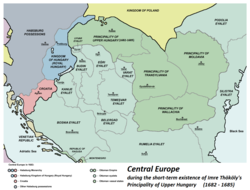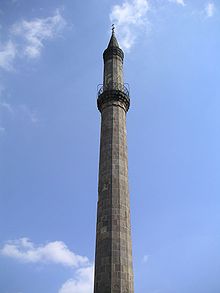| Revision as of 13:59, 14 February 2012 edit99.225.51.145 (talk) →History← Previous edit | Revision as of 09:43, 18 March 2012 edit undoWikiEditor2004 (talk | contribs)Autopatrolled, Extended confirmed users51,646 editsm PANONIAN moved page History of Ottoman Hungary to History of Hungary during Ottoman administration: betterNext edit → | ||
| (No difference) | |||
Revision as of 09:43, 18 March 2012
History of Ottoman Hungary refers to the history of parts of the Ottoman Empire situated in what today is Hungary, in the period from 1541 to 1699.
History


By the sixteenth century, the power of the Ottoman Empire had increased gradually, as did the territory controlled by them in the Balkans, while the Kingdom of Hungary was weakened by the peasants' uprisings. Under the reign of Louis II Jagiellon (1516–1526), internal dissentions divided the nobility.
Provoked into war by diplomatic insult, Suleyman the Magnificent (1520–1566) attacked the Kingdom of Hungary and captured Belgrade in 1521. He did not hesitate to launch an attack against the weakened kingdom, whose smaller (approximately 26,000 compared to 45,000 soldiers) badly led army was defeated on 29 August 1526 at the Battle of Mohács. Thus he became influential in the Kingdom of Hungary, while his semi-vassal, named John I Zápolya and his enemy Ferdinand I both claimed the throne of the Kingdom. Suleyman went further and tried to crush Austrian forces, but his siege of Vienna in 1529 failed after the onset of winter forced his retreat. The title of king of Hungary was disputed between Zápolya and Ferdinand until 1540. After the seizure of Buda by the Ottomans in 1541, the West and North recognized a Habsburg as king ("Royal Hungary"), while the central and southern counties were annexed by the Ottoman Sultan and the east was ruled by the son of Zápolya under the name Eastern Hungarian Kingdom which after 1570 became the Principality of Transylvania. Whereas a great many of the seventeen and nineteen thousands Ottoman soldiers in service in the Ottoman fortresses in the territory of present-day Hungary were Orthodox and Muslim Balkan Slavs. Southern Slavs were also acting as akinjis and other light troops intended for pillaging in the territory of present-day Hungary.
During Ottoman administration, peace was fragile: the Habsburgs pursued plans to take the land from the Muslim control, and to promote the Counterreformation with the help of agents. Using Ottoman-controlled territory of present-day Hungary as their base, the Ottomans attempted to use this religious division of their Christian opponents in 1620, and again in 1683 with the second siege of Vienna.
In these times, territory of present-day Hungary began to undergo changes. Vast lands remained unpopulated and covered with woods. Flood plains became marshes. The life of the inhabitants on Ottoman the side was unsafe. Peasants fled to the woods and marshes, forming guerrilla bands, known as the Hajdú troops. Eventually, territory of present-day Hungary became a drain on the Ottoman Empire, swallowing much of its revenue into the maintenance of a long chain of border forts. However, some parts of the economy flourished. In the huge unpopulated areas, townships bred cattle that were herded to south Germany and northern Italy - in some years the number of exported cattle reached 500,000 animals. Wine was traded to the Czech lands, Austria and Poland.
But in the end continuous wars, Ottoman administration and Habsburg repression ruined the area.
The defeat of Ottoman forces led by Grand Vizier Kara Mustafa Pasha at the Second Siege of Vienna in 1683, at the hands of the combined armies of Poland and the Holy Roman Empire under John III Sobieski, was the decisive event that marked the beginning of the stagnation of the Ottoman Empire, and ultimately swung the balance of power in the region. Under the terms of the Treaty of Karlowitz, which ended the Great Turkish War in 1699, the Ottomans ceded to Habsburgs much of the territory they had previously taken from the medieval Kingdom of Hungary. Following this treaty, the members of the Habsburg dynasty administered much enlarged Habsburg Kingdom of Hungary (previously they controlled only area known as "Royal Hungary"; see Kingdom of Hungary (1538–1867)).
Administration
The territory was divided into Eyalets (provinces), which were further divided into Sanjaks, with the highest ranking Ottoman official being the Pasha of Budin. At first, Ottoman-controlled territories in present-day Hungary were part of the Budin Eyalet. Later, new eyalets were formed: Temeşvar Eyalet, Zigetvar Eyalet, Kanije Eyalet, Egir Eyalet, and Varat Eyalet. Administrative centers of Budin, Zigetvar, Kanije and Egir eyalets were located in the territory of present-day Hungary, while Temeşvar and Varat eyalets that had their administrative centers in the territory of present-day Romania also included some parts of present-day Hungary. Likewise, Budin, Zigetvar, Kanije and Egir eyalets also included parts of present-day Serbia, Croatia and Kosovo. Pashas and Sanjak-Beys were responsible for administration, jurisdiction and defense. The Ottomans' only interest was to secure their hold on the territory. The Sublime Porte (a term used to designate the Ottoman rulers) became the sole landowner and managed about 20 percent of the land for its own benefit, apportioning the rest among soldiers and civil servants. The Ottoman landlords were interested mainly in squeezing as much wealth from the land as quickly as possible. Of major importance to Istanbul was the collection of taxes. Taxation left little for the former landlords to collect; Most of the nobility and large numbers of burghers emigrated into the Habsburg Kingdom of Hungary ("Royal Hungary") province. Wars, slave-taking, and the emigration of nobles who lost their land caused a depopulation of the countryside. However, the Ottomans practiced relative religious tolerance and allowed the various ethnicities living within the empire significant autonomy in internal affairs. Towns maintained some self-government, and a prosperous middle class developed through artisanry and trade.
Culture
See also: Culture of the Ottoman EmpireDespite the continuous warfare with the Habsburgs, several cultural centres sprang up in this far corner of the Empire. Examples of Ottoman architecture of the classical period, seen in the famous centers of Istanbul and Edirne, were also seen in the territory of present-day Hungary, where mosques, bridges, fountains, baths and schools were built. Unfortunately, after the Habsburg conquest, most of these works were destroyed and few survive to this day. The introduction of Turkish Baths, with the building of the Rudas Baths, was the beginning of a long tradition in the territory of present-day Hungary. No less than 75 hammams (steam baths) were built during the Ottoman age.
Muslim schools
In the seventeenth century, 165 elementary (mekteb) and 77 secondary and academic theological schools (medrese) were operating in 39 of the major towns of the region. The elementary schools taught writing, basic arithmetics, and the reading of the Koran and of the most important prayers. The medreses carried out secondary and academic training within the fields of Muslim religious sciences, Church law and Natural sciences. Most medreses operated in Budin (Buda), where there were twelve. In Peçuy (Pécs) there were five medreses, Eğri had four. The most famous medrese in Ottoman-controlled territory of present-day Hungary was that of Budin (Buda), built by the Bosnian Muslim Serb Mehmed-pasha Sokolović during his seventeen years of governing (1566–1578).
In the mosques, people not only prayed, but were taught to read and write, to read the Koran, and prayers. The sermons were the most effective form of political education. There were numerous elementary and secondary schools besides the mosques, and the monasteries of the Dervish orders also served as centers of culture and education. The spread of culture was supported by the libraries. The school library of Mehmed-pasha Sokolović in Budin (Buda), contained, besides Muslim religious sciences, other literature, works on oratory, poetry, astronomy, music, architecture, and medical sciences.
Religion


The Ottomans practiced relative religious tolerance, and Christianity was not prohibited, though Christians were treated as second-class citizens. According to Thomas Walker Arnold, Islam was not spread by force in the areas under the control of the Ottoman Sultan, however, Arnold concludes by quoting a 17th century author who stated:
Meanwhile he wins by craft more than by force, and snatches away Christ by fraud out of the hearts of men. For the Turk, it is true, at the present time compels no country by violence to apostatise; but he uses other means whereby imperceptibly he roots out Christianity...
The large numbers of converts to Islam, who, alongside the approximately 80,000 Muslim settlers, contributed to the constantly growing Muslim population in Ottoman-controlled territory of present-day Hungary. The religious life of the Muslims was supervised by the mosques that were either newly built or transformed from older Christian churches. Payment for the servants of the mosques, as well as the maintenance of the churches, was the responsibility of the Ottoman state or charities.
Besides Sunni Islam, a large number of dervish communities also flourished including the bektashis, the halvetis, and the mevlevis. The famous Gül Baba monastery of Budin (Buda), sheltering 60 dervishes, belonged to the bektasi order. Situated close to the janissaries camp, it was built by Jahjapasazáde Mehmed Pasha, the third begler bey (governor) of Budin (Buda). The türbe (mausoleum) in Budapest of the famous dervish and poet Gül Baba is to this day the northernmost site of Islamic pilgrimage.
Another famous monastery of its time was that of the halveti dervishes. Built around 1576 next to the türbe of Sultan Süleyman I the Magnificent (1520–1566) in Sigetvar (Szigetvár), it soon became the religious and cultural centre of the area. A famous prior of the zavije (monastery) was the Bosnian Sejh Ali Dede. The monastery of Jakovali Hassan Pasha in Peçuy (Pécs) was another famous location. Its most outstanding prior was Mevlevian dervish Pecsevi Árifi Ahmed Dede, a Turk and native of Peçuy (Pécs).
Ethnic aftermath of Ottoman wars
As a consequence of the 150 years of constant warfare between the Christian states and Ottomans, population growth was stunted, and the network of ethnic Hungarian medieval settlements, with their urbanized bourgeois inhabitants, perished. The ethnic composition of the territory that formerly was part of the medieval Kingdom of Hungary was fundamentally changed through deportations and massacres, so that the number of ethnic Hungarians in existence at the end of the Ottoman period was substantially diminished.
See also
Gallery
References
- Melvin E. Page, Colonialism: an international social, cultural, and political encyclopedia, ABC-CLIO, 2003, p. 648
- Laszlo Kontler, "A History of Hungary" p. 145
- Inalcik Halil: "The Ottoman Empire"
- The preaching of Islam: a history of the propagation of the Muslim faith By Sir Thomas Walker Arnold, pg. 135-144
- The preaching of Islam: a history of the propagation of the Muslim faith By Sir Thomas Walker Arnold, pg. 136
- Christina Shea, Joseph S. Lieber, Erzsébet Barát, Frommer's Budapest & the Best of Hungary, John Wiley and Sons, 2004, p 122-123
- Csepeli, Gyorgy (1996). "The changing facets of Hungarian nationalism - Nationalism Reexamined". Social Research.

This image is available from the United States Library of Congress Prints and Photographs Division under the digital ID {{{id}}}
This tag does not indicate the copyright status of the attached work. A normal copyright tag is still required. See Misplaced Pages:Copyrights for more information.
- Encyclopaedia Humana Hungarica: Cross and Crescent: The Turkish Age in Hungary (1526–1699)
- Balázs Sudár: Baths in Ottoman Hungary in "Acta Orientalia Academiae Scientiarum Hungaricae", Volume 57, Number 4, 7 December 2004, pp. 391–437(47)
External links
| Ottoman period by modern country or region | |
|---|---|
| Africa | |
| Asia | |
| Europe | |




